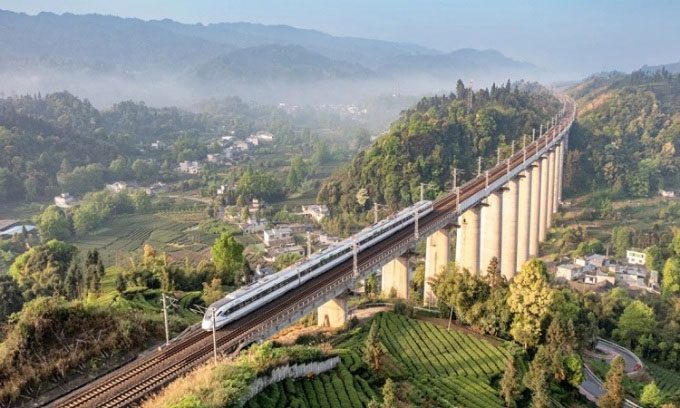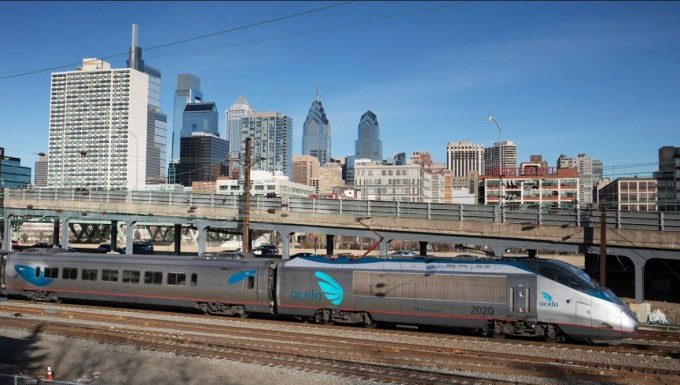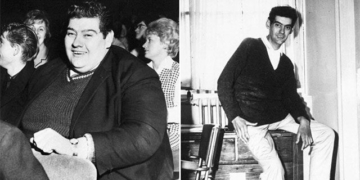The Dependence on Airplanes and Cars Leaves the U.S. Lagging Behind in High-Speed Rail Development.
High-speed trains have demonstrated their value worldwide over the past 50 years. This mode of transportation not only reduces travel time but also boosts economic development, creates jobs, and brings communities closer together. China, Japan, and Europe are leading the way in high-speed rail development. So why doesn’t the U.S. have a high-speed rail network like those countries? For a wealthy nation with the most advanced economy on the planet and an urban population of over 300 million, this situation is becoming increasingly difficult to justify, according to CNN.

A bullet train passing through a tea garden in Sichuan Province, China. (Photo: Liu Guoxing/VCG).
While Japan pioneered the trend with the Shinkansen bullet train in 1964, it wasn’t until the TGV line in France was introduced in the early 1980s that the global high-speed rail revolution officially began. However, this revolution has been largely overlooked by the U.S. until recently. Americans have become almost entirely dependent on highways and air travel. Since 2008, China has constructed approximately 42,000 kilometers of high-speed rail and plans to expand this to 70,000 kilometers by 2035. In contrast, the U.S. has only 604 kilometers of rail operating at speeds over 160 km/h.
Many Americans lack an understanding of high-speed rail and do not see its value. They are accustomed to highways and air travel, according to William C. Vantuono, editor-in-chief of Railway Age, the oldest publication in the North American rail industry. Cars and planes have dominated long-distance travel in the U.S. since the 1950s, quickly surpassing passenger train networks. Iconic railroads like New York Central went bankrupt in the early 1970s and had to transfer their trains to Amtrak, the state-run passenger train company established in 1971.
President Joe Biden’s $1.2 trillion infrastructure bill includes $170 billion dedicated to rail improvements. Part of this funding will be used to repair Amtrak’s dilapidated Northeast Corridor (NEC), connecting Boston, New York, and Washington. Additionally, there are several major plans to bring passenger trains back to cities across the country, providing fast and sustainable transportation.
Furthermore, the private passenger rail project Brightline has been granted permission to build a $10 billion high-speed rail line between Los Angeles and Las Vegas by 2027, along with plans in California, Texas, and the Cascadia corridor connecting Portland, Oregon, with Seattle and Vancouver. Finally, the U.S. is beginning to catch up with the passenger rail revolution.

Amtrak plans to introduce the new Avelia Liberty train to replace the aging Acela. (Photo: AP).
Only Amtrak’s Northeast Corridor has trains operating at speeds close to the nearly 300 km/h of the TGV and Shinkansen. Even there, Amtrak’s current Acela train has a maximum speed of 241 km/h but only for short distances. The maximum speed elsewhere is nearly 160 km/h on tracks shared with freight trains.
This year, Amtrak plans to introduce the new Avelia Liberty train to replace the old Acela on the NEC. Capable of reaching speeds up to 354 km/h, this train will bring the latest high-speed rail technology from Alstom to North America. The locomotive is a close relative of the next-generation TGV-M, which is expected to enter service in France in 2024.
In March 2023, Brightline confirmed plans to build a 351 km high-speed rail line between Rancho Cucamonga, near Los Angeles, and Las Vegas, passing through the San Bernardino Mountains and desert. This 320 km/h railway will reduce travel time between the two cities to just over one hour, compared to an average of 4 hours by car or 5 to 7 hours by bus when it opens in 2027. The project also marks the return of passenger trains to Las Vegas after a 30-year absence. Brightline hopes to attract about 12 million passengers out of 50 million one-way trips annually between Las Vegas and Los Angeles.
Meanwhile, another high-speed rail project through the San Joaquin Valley is under construction. Expected to open in 2030, the California High-Speed Rail (CHSR) will run from Merced to Bakersfield (275 km) at speeds of 354 km/h. Combined with upgrades to urban rail at both ends, the project will enable high-speed trains to cover 560 km from Los Angeles to San Francisco in just 2 hours and 40 minutes.
The CHSR project was proposed in 1996, but its construction has been contentious. Disagreements over routing, management issues, delays in land acquisition, rising costs, and a lack of funding to complete the entire system have stalled the project. With costs estimated between $63 billion to $98 billion depending on the final scope, CHSR will connect 6 of the 10 largest cities in the state. With California’s population projected to exceed 45 million by 2050, high-speed rail will provide the best solution to reduce congestion and pollution. By focusing on areas that are too close for air travel or too far for driving, planners can identify rail corridors with the greatest potential.
Globally, about three-quarters of passenger railways are electrified, giving this mode of transportation a unique status to leverage renewable energy in the coming decades. Here, the U.S. also lags behind the world. Rail networks in South Korea, Japan, Europe, China, and Russia have electrified over 60%, with South Korea holding the highest rate at 85%. In contrast, in North America, less than 5% of rail lines have electric trains.
The vast size of the U.S. and its widely dispersed population limit the ability to create a unified rail network like those in China and Europe. Air travel remains the preferred option for intercontinental journeys. However, there are many shorter intercity corridors where rail can offer an optimal alternative to planes and cars.


















































